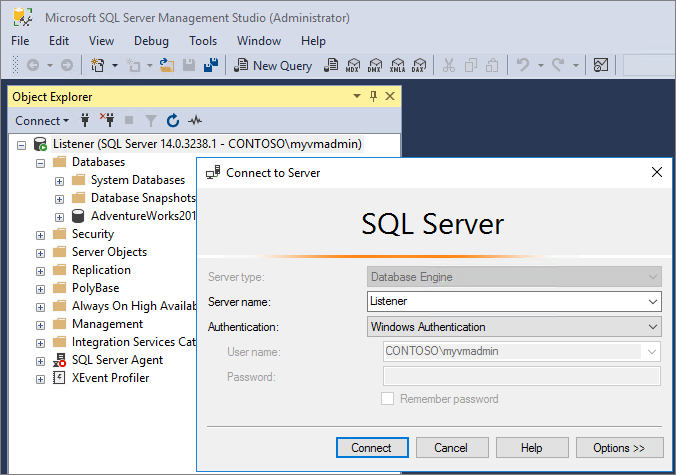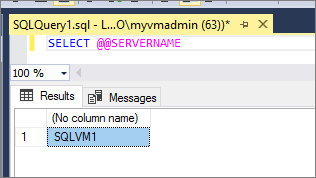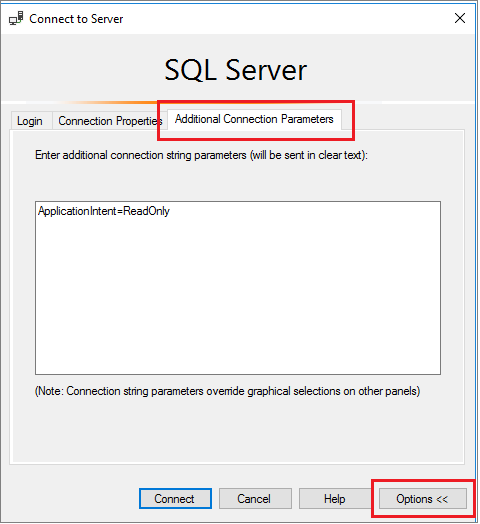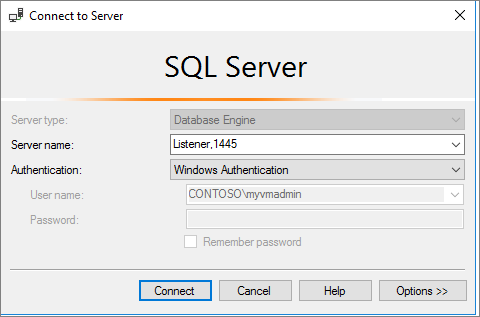Connect to an Always On availability group listener
Applies to:
SQL Server
This article teaches you how to connect to an Always On availability group listener for SQL Server. An availability group listener is a virtual network name that clients use to connect to a database hosted in an availability group. The listener provides a consistent connection endpoint for client applications, regardless of which availability replica is currently hosting the primary database. The listener also enables support for read-only routing and automatic failover.
After you've configured your listener, update your connection strings to point to the listener so that application traffic is automatically routed to the intended replica without having to manually update the connection string after every failover.
Connect to the primary replica
Specify the availability group listener DNS name in the connection string to connect to the primary replica for read-write access.
For example, to connect to the primary replica in SQL Server Management Studio through the listener, enter the listener DNS name in the server name field:

During a failover, when the primary replica changes, existing connections to the listener are disconnected and new connections are routed to the new primary replica.
An example of a basic connection string for the ADO.NET provider (System.Data.SqlClient):
Server=tcp: AGListener,1433;Database=MyDB;Integrated Security=SSPI
You can verify which replica you're currently connected to through the listener by running the following Transact-SQL (T-SQL) command:
SELECT @@SERVERNAME
For example, when SQLVM1 is my primary replica:

You can still connect directly to the instance of SQL Server using the instance name of the primary or secondary replica instead of using the availability group listener. However, you'll then lose the benefit of new connections being routed automatically to the new current primary replica. Additionally, you'll lose the benefit of read-only routing, where connections specified with read-intent are automatically routed to the readable secondary replica.
Connect to a read-only replica
Read-only routing refers to automatically routing incoming listener connections to a readable secondary replica that is configured to allow read-only workloads.
Connections are automatically routed to the read-only replica if the following are true:
At least one secondary replica is set to read-only access, and each read-only secondary replica and the primary replica are configured to support read-only routing.
The connection string references a database involved in the Availability Group. An alternative to this would be the login used in the connection has the database configured as its default database. For more information, see this article on how the algorithm works with read-only routing.
The connection string references an availability group listener, and the application intent of the incoming connection is set to read-only (for example, by using the Application Intent=ReadOnly keyword in the ODBC or OLEDB connection strings or connection attributes or properties).
The application intent attribute is stored in the client's session during login and the instance of SQL Server will then process this intent and determine what to do according to the configuration of the availability group and the current read-write state of the target database in the secondary replica.
For example, to connect to a read-only replica using SQL Server Management Studio, select Options on the Connect to Server dialog box, select the Additional Connection Parameters tab, and then specify ApplicationIntent=ReadOnly in the text box:

An example of a connection string for the ADO.NET provider (System.Data.SqlClient) that designates read-only application intent:
Server=tcp:AGListener;Database=AdventureWorks;Integrated Security=SSPI;ApplicationIntent=ReadOnly
For more information, see Configure Read-Only Access on an Availability Replica (SQL Server)
Nondefault port
When creating your listener, you designate a port for the listener to use. If the port is the default port of 1433, then you don't have to specify a port number when connecting to your listener. However, if the port isn't 1433, then the port must be specified in the connection string in the format of listenername,port such as:

An example of a connection string for the ADO.NET provider (System.Data.SqlClient) that specifies a nondefault port for the listener:
Server=tcp:AGListener,1445;Database=AdventureWorks;Integrated Security=SSPI
Bypass listeners
While availability group listeners enable support for failover redirection and read-only routing, client connections aren't required to use them. A client connection can also directly reference the instance of SQL Server instead of connecting to the availability group listener.
To the instance of SQL Server, it's irrelevant whether a connection logs in using the availability group listener or using another instance endpoint. The instance of SQL Server verifies the state of the targeted database and either allow or disallow connectivity based on the configuration of the availability group and the current state of the database on the instance. For example, if a client application connects directly to an instance of SQL Server port and connects to a target database hosted in an availability group, and the target database is in primary state and online, then connectivity succeeds. If the target database is offline or in a transitional state, connectivity to the database will fail.
Alternatively, while migrating from database mirroring to Always On availability groups, applications can specify the database mirroring connection string as long as only one secondary replica exists and it disallows user connections.
Database mirroring connection strings
If an availability group possesses only one secondary replica and is configured with either ALLOW_CONNECTIONS = READ_ONLY or ALLOW_CONNECTIONS = NONE for the secondary replica, clients can connect to the primary replica by using a database mirroring connection string. This approach can be useful while migrating an existing application from database mirroring to an availability group, as long as you limit the availability group to two availability replicas (a primary replica and one secondary replica). If you add additional secondary replicas, you'll need to create an availability group listener for the availability group and update your applications to use the availability group listener DNS name.
When using database mirroring connection strings, the client can use either SQL Server Native Client or .NET Framework Data Provider for SQL Server. The connection string provided by a client must minimally supply the name of one server instance, the initial partner name, to identify the server instance that initially hosts the availability replica to which you intend to connect. Optionally, the connection string can also supply the name of another server instance, the failover partner name, to identify the server instance that initially hosts the secondary replica as the failover partner name.
For more information about database mirroring connection strings, see Connect Clients to a Database Mirroring Session (SQL Server).
Multi-subnet failovers
If you're using client libraries that support the MultiSubnetFailover connection option in the connection string, you can optimize availability group failover to a different subnet by setting MultiSubnetFailover to "True" or "Yes", depending on the syntax of the provider you're using.
Note
We recommend this setting for both single and multi-subnet connections to availability groups listeners and to SQL Server Failover Cluster Instance names. Enabling this option adds additional optimizations, even for single-subnet scenarios.
The MultiSubnetFailover connection option only works with the TCP network protocol and is only supported when connecting to an availability group listener and for any virtual network name connecting to SQL Server.
An example of the ADO.NET provider (System.Data.SqlClient) connection string that enables multi-subnet failover is as follows:
Server=tcp:AGListener,1433;Database=AdventureWorks;Integrated Security=SSPI; MultiSubnetFailover=True
The MultiSubnetFailover connection option should be set to True even if the availability group only spans a single subnet. This allows you to preconfigure new clients to support future spanning of subnets without any need for future client connection string changes and also optimizes failover performance for single subnet failovers. While the MultiSubnetFailover connection option isn't required, it does provide the benefit of a faster subnet failover. This is because the client driver attempts to open up a TCP socket for each IP address in parallel associated with the availability group. The client driver waits for the first IP to respond with success and once it does, will then use it for the connection.
Listeners & TLS/SSL certificates
When connecting to an availability group listener, if the participating instances of SQL Server use TLS/SSL certificates in conjunction with session encryption, the connecting client driver needs to support the Subject Alternate Name in the TLS/SSL certificate in order to force encryption.
An X.509 certificate must be configured for each participating server node in the failover cluster with a list of all availability group listeners set in the Subject Alternate Name of the certificate.
The format for the certificate values is:
CN = Server.FQDN
SAN = Server.FQDN,Listener1.FQDN,Listener2.FQDN
For example, you have the following values:
Servername: Win2019
Instance: SQL2019
AG: AG2019
Listener: Listener2019
Domain: contoso.com (which is also the FQDN)
For a WSFC that has a single availability group, the certificate should have the fully qualified domain name (FQDN) of the server, and the FQDN of the listener:
CN: Win2019.contoso.com
SAN: Win2019.contoso.com, Listener2019.contoso.com
With this configuration, your connections is encrypted when connecting to the instance (WIN2019\SQL2019), or the listener (Listener2019).
Depending on how networking is configured, there's a small subset of customers that might need to add the NetBIOS to the SAN as well. In which case, the certificate values should be:
CN: Win2019.contoso.com
SAN: Win2019,Win2019.contoso.com,Listener2019,Listener2019.contoso.com
If the WSFC has three availability group listeners, such as: Listener1, Listener2, Listener3
Then the certificate values should be:
CN: Win2019.contoso.com
SAN: Win2019.contoso.com,Listener1.contoso.com,Listener2.contoso.com,Listener3.contoso.com
Listeners and Kerberos (SPNs)
A domain administrator must configure a Service Principal Name (SPN) in Active Directory for each availability group listener to enable Kerberos for client connections to the listener. When registering the SPN, you must use the service account of the server instance that hosts the availability replica. For the SPN to work across all replicas, the same service account must be used for all instances in the WSFC cluster that hosts the availability group.
Use the setspn Windows command line tool to configure the SPN. For example to configure an SPN for an availability group listener named AG1listener.Adventure-Works.com hosted on a set of instances of SQL Server all configured to run under the domain account corp\svclogin2:
setspn -A MSSQLSvc/AG1listener.Adventure-Works.com:1433 corp\svclogin2
For more information about manual registration of an SPN for SQL Server, see Register a Service Principal Name for Kerberos Connections.